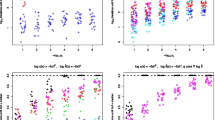Abstract
We study in limit law the complexity of some anticipated rejection random sampling algorithms. We express this complexity in terms of a probabilistic process, the threshold sum process. We show that, under the right conditions, the complexity is linear and admits as a limit law a so-called Darling–Mandelbrot distribution, studied by Darling (Trans Am Math Soc 73:95–107, 1952) and Lew (Constr Approx 10(1):15–30, 1994). We also give an explicit form to the density of the Darling–Mandelbrot distribution and derive some of its analytic properties.




Similar content being viewed by others
Notes
Given the definition of the Gamma function \(\varGamma (y) = \int _0^{\infty } x^{y-1} e^{-x} {\mathrm {d}}x\), the upper and lower incomplete versions are defined through the corresponding integrals on modified domains \(\varGamma (y,z) = \int _z^{\infty } \cdot \;\) and \(\gamma (y,z) = \varGamma (y)-\varGamma (y,z) = \int _0^z \cdot \;\), respectively. Non-positive real values of z are reached by analytic continuation.
The sum in this expression can be seen as a special case of the Lauricella function \(F_B^{(k)}\) where all variables are specialized to \(-x\).
To sample these, a better (in fact, optimal) algorithm consists in using the algorithm of [2] to sample a pointed binary plane tree and using classical bijections to get a Dyck prefix.
The condition on the form of the left-hand side can be relaxed to some extent, we treat here a simplified situation in order to lighten the notation.
This question has been posed also by the anonymous referee.
The positivity property still holds for the homogeneous, more refined polynomials associated to the equation
$$\begin{aligned}&(2x+y+z)F_n = F_{n+1} + x(y+z)(2x+y+z) F_{n-2}\\&F_0=0\,;\quad F_1=1\,;\quad F_2=x + y\,. \end{aligned}$$We thank M. Bousquet-Mélou and K. Rashel or pointing out this reference.
It is worth noting that, still on \({\mathbb {N}} \times {\mathbb {Z}}\), and at generic k, in the variant in which the endpoints are prescribed, exact enumeration formulas allow for an efficient algorithm, involving no anticipated rejection (see [6, Chapt. 4]). We thank the anonymous referee for pointing us towards this reference.
Incidentally, note that also in the directed case the formula for \(\alpha (k)\) matches with the trivial value \(\alpha =0\) for problem (P1).
References
Bacher, A.: Directed and multi-directed animals in the king’s lattice. Submitted (2014). arxiv:1301.1365
Bacher, A., Bodini, O., Jacquot, A.: Efficient random sampling of binary and unary-binary trees via holonomic equations. Submitted (2014) arxiv:1401.1140
Banderier, C., Flajolet, P.: Basic analytic combinatorics of directed lattice paths. Theor. Comput. Sci. 281, 37–80 (2002). (special volume dedicated to M. Nivat)
Barcucci, E., Pinzani, R., Sprugnoli, R.: The random generation of directed animals. Theor. Comput. Sci. 127(2), 333–350 (1994). doi:10.1016/0304-3975(94)90046-9. ISSN 0304-3975
Barcucci, E., Pinzani, R., Sprugnoli, R.: The random generation of underdiagonal walks. Discrete Math. 139(1–3), 3–18 (1995). doi:10.1016/0012-365X(94)00121-X. ISSN 0012-365X. Formal power series and algebraic combinatorics (Montreal, PQ, 1992)
Bonichon, N.: Aspects algorithmiques et combinatoires des réaliseurs des graphes plans maximaux. PhD thesis, Université Sciences et Technologies – Bordeaux I, (2002)
Bousquet-Mélou, M., Mishna, M.: Walks with small steps in the quarter plane. Contemp. Math. 520, 1–40 (2010)
Darling, D .A.: The influence of the maximum term in the addition of independent random variables. Trans. Am. Math. Soc. 73, 95–107 (1952). ISSN 0002-9947
Denisov, D., Wachtel, V.: Random walks in cones. Ann Probab 43(3), 992–1044 (2015). arxiv:1110.1254
Duplantier, B.: Random walks and quantum gravity in two dimensions. Phys. Rev. Lett 81, 5489–5492 (1998). doi:10.1103/PhysRevLett.81.5489
Gnedenko, B.V., Kolmogorov, A.N.: Limit distributions for sums of independent random variables. Translated from the Russian, annotated, and revised by K. L. Chung. With appendices by J. L. Doob and P. L. Hsu. Revised edition. Addison-Wesley Publishing Co., Reading (1968)
Knizhnik, V.G., Polyakov, A.M., Zamolodchikov, A.B.: Fractal structure of \(2{D}\)-quantum gravity. Mod. Phys. Lett. A 03(08), 819–826 (1988). doi:10.1142/S0217732388000982
Lawler, G., Schramm, O., Werner, W.: Values of brownian intersection exponents, i: Half-plane exponents. Acta Mathematica 187(2), 237–273 (2001a). doi:10.1007/BF02392618. ISSN 0001-5962
Lawler, G., Schramm, O., Werner, W.: Values of brownian intersection exponents, ii: Plane exponents. Acta Mathematica 187(2), 275–308 (2001b). doi:10.1007/BF02392619. ISSN 0001-5962
Lawler, G .F., Schramm, O., Werner, W.: Values of brownian intersection exponents III: Two-sided exponents. Annales de l’Institut Henri Poincare (B). Probab. Stat. 38(1), 109–123 (2002). doi:10.1016/S0246-0203(01)01089-5. ISSN 0246-0203
Lew, J .S.: On the Darling-Mandelbrot probability density and the zeros of some incomplete gamma functions. Constr. Approx. 10(1), 15–30 (1994). doi:10.1007/BF01205164. ISSN 0176-4276
Louchard, G.: Asymptotic properties of some underdiagonal walks generation algorithms. Theor. Comput. Sci. 218(2), 249–262 (1999). doi:10.1016/S0304-3975(98)00324-7. ISSN 0304-3975. Caen ’97
Penaud, J.-G., Pergola, E., Pinzani, R., Roques, O.: Chemins de Schröder et hiérarchies aléatoires. Theor. Comput. Sci. 255(1–2), 345–361 (2001). doi:10.1016/S0304-3975(99)00293-5. ISSN 0304-3975
Redner, S.: A guide to first-passage processes. Cambridge University Press, Cambridge (2001). doi:10.1017/CBO9780511606014
Author information
Authors and Affiliations
Corresponding author
Additional information
Axel Bacher: Supported by FWF project F050-04 (Austria).
Andrea Sportiello: Supported by ANR Magnum project BLANC 0204 (France).
Rights and permissions
About this article
Cite this article
Bacher, A., Sportiello, A. Complexity of Anticipated Rejection Algorithms and the Darling–Mandelbrot Distribution. Algorithmica 75, 812–831 (2016). https://doi.org/10.1007/s00453-015-0040-8
Received:
Accepted:
Published:
Issue Date:
DOI: https://doi.org/10.1007/s00453-015-0040-8




